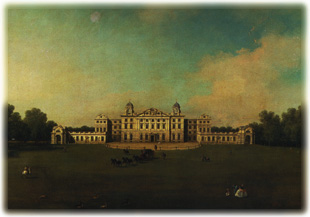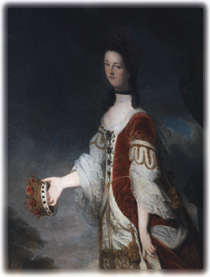Main Menu · Search · Current Issue · Contact · Archives · Centennial · Letters to the Editor · FAQs
![]()
Main Menu ·
Search · Current Issue · Contact · Archives · Centennial · Letters to the Editor · FAQs

| High School Physics: A Dead End? | Consuming Passions | |
| Cockpit Teamwork | Antimatter: Some Like It Cold | |
| E-mail and Web Information | ||
 A view of Badminton, seat of the Beauforts and birthplace of the racquet game.PAINTING BY CANALETTO/COURTESY THE BADMINTON ESTATE
A view of Badminton, seat of the Beauforts and birthplace of the racquet game.PAINTING BY CANALETTO/COURTESY THE BADMINTON ESTATE |
The popular stereotype of female consumers involves wanton, feckless women shopping until they drop," says Maura Henry, Ph.D. '96, lecturer on history and women's studies. "And aristocratic women are seen as indulgers par excellence--they have no jobs, they're wealthy--what else could they be doing but spending their husbands' money?"
That image, though popular, may reflect male anxieties rather than female behavior. Although limited to a single individual, Henry's historical study of how an eighteenth-century English duchess managed her money contradicts such stereotypes of upper-class female consumers. Her research on Elizabeth Berkeley Somerset (1719-99), the fourth duchess of Beaufort, took her to the Beaufort private archive, which holds a two-volume, thousand-page index of family papers that go back to the Middle Ages. The eleventh duke and duchess of Beaufort allowed Henry access to the archive; she is only the third scholar to be so authorized.
Eighteenth-century England, generally considered the first fully industrialized and capitalized country in history, is a crucial site for studies of consumption because modern consumer society first emerged there, as an English middle class developed and more people had ready cash to spend. But what to buy? "Thorstein Veblen said there's an emulative impulse in consumption--keeping up with the Joneses," says Henry. "We assume the middle classes wanted to consume as the nobility did. But what we know of aristocratic consumption is mainly stereotype promulgated by contemporary middle-class pundits and preachers, who denounced it as feminine, unproductive, and immoral."
Henry's protagonist married in 1740 at age 21 and was widowed 16 years later. Throughout her married life and the 43 years of her widowhood, the duchess supervised seven households--massive estates that the family owned in England and Wales. She kept meticulous financial records and paid off an immense family debt that dated to the time of the second duke. "She unloaded the preexisting debt without selling off capital assets, and essentially saved the family from financial ruin," Henry says, then adds, with a grin, "The boys ran up bills."
The duchess's papers include 59 years of double-entry account books, meticulously recording personal, household, and children's expenses. "She kept all the receipts to back up the books," says Henry. "Even for items as small as 'a piece of ribbon--one shilling.'" Aristocrats did most of their buying with lines of credit, not cash--another fact that fuels notions of upper-class women spending without any regard for the
consequences. But as a consumer, the duchess was actually "a tough cookie," Henry says. "When she buys things, she demands full value." For example, when some pieces of art she had purchased in Italy were broken en route back to England, Henry notes that the duchess "was insistent about getting satisfaction."
 A portrait, at Badminton, of the fourth duchess. MAURA HENRY |
She also managed the income side of the ledger quite adroitly. She lent money to other aristocrats, at profitable rates: in her account book she noted, "8 percent interest...good." The family owned coal mines--perhaps half of the mines in Wales--and during the eighteenth century the demand for coal rose markedly, allowing the duchess to fill her family's coffers by running a booming energy business.
When it came to shopping, Henry says, "Most of her larger purchases were done with an eye to posterity: expensive artworks, improvements to the houses." The family's main seat is Badminton, a 143-room estate in western Gloucestershire. (Two aunts of the family, in fact, are credited with having invented the eponymous racquet game one rainy day; a badminton court's dimensions match those of the house's grand entry.) The duchess installed an Italian marble and porphyry fireplace, designed by the papal architect. She acquired chandeliers and rebuilt the chapel and the archive room. "She invested in things of a permanent nature, with symbolic significance," says Henry. "Things that have meaning for the family.
"All consumers are to some extent idiosyncratic, of course," she continues. "It appears that class and status play a more significant role in shaping a consumer's behavior than does gender. My conclusions are still in process but, beyond the practices of consumption, I want to get at the theoretical implications of consumption. Uncovering the business acumen of some aristocratic women confronts us with a picture of society very different from the one we have now."
~Craig Lambert
Main Menu ·
Search · Current Issue · Contact · Archives · Centennial · Letters to the Editor · FAQs
![]()